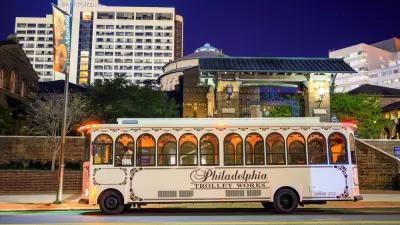In PlanPhilly, a discussion on Jarrett Walker's brand of humanities-infused transit planning. The wonky stuff is all well and good, but in the end it's all about simple access and freedom of movement.

"'Frequency is freedom,' said Jarrett Walker, earnestly in a philosophy lecture disguised as a talk on transit planning." [...] "'We all have a sense about freedom and imprisonment—It's about not being able to move. We are all in a prison, physically speaking, where the walls are where we can get to in a reasonable amount of time.'"
Jim Saksa writes about Walker's approach to transit planning, emphasizing the human dynamic before getting technical. For one thing, Walker insists on distinguishing between the "choice" rider (someone who has another option) and the "dependent" rider (somebody who must take the bus). "Imagine what kind of service the dependent bus rider would want, and deliver that, rather than trying to dream up a service for the choice rider."
Walker tends to eschew ridership predictions and overly-complex models. "It may be my philosophical training: I start with skepticism. [...] I start with what I know. That's why I start with geometry—I'm sure about that, and in a way that I'm not sure with psychology or human behavior."
Saksa suggests that SEPTA can take several lessons from Walker. "First, Walker emphasized the importance of maps—particularly frequency maps—in conveying the freedom offered by a transit system to its potential riders. Second, Walker noted that straight routes aligned in grid systems maximize a rider's abundance of access."
Read more from Jarrett Walker at his blog, Human Transit.
FULL STORY: Jarrett Walker's philosophy of public transit as means to freedom

Pennsylvania Mall Conversion Bill Passes House
If passed, the bill would promote the adaptive reuse of defunct commercial buildings.

Planning for Accessibility: Proximity is More Important than Mobility
Accessibility-based planning minimizes the distance that people must travel to reach desired services and activities. Measured this way, increased density can provide more total benefits than increased speeds.

World's Largest Wildlife Overpass In the Works in Los Angeles County
Caltrans will soon close half of the 101 Freeway in order to continue construction of the Wallis Annenberg Wildlife Crossing near Agoura Hills in Los Angeles County.

Eviction Looms for Low-Income Tenants as Rent Debt Rises
Nonprofit housing operators across the country face almost $10 billion in rent debt.

Brightline West Breaks Ground
The high-speed rail line will link Las Vegas and the Los Angeles area.

Colorado Bans No-Fault Evictions
In most cases, landlords must provide a just cause for evicting tenants.
City of Costa Mesa
Licking County
Barrett Planning Group LLC
HUD's Office of Policy Development and Research
Mpact Transit + Community
HUD's Office of Policy Development and Research
Tufts University, Department of Urban and Environmental Policy & Planning
City of Universal City TX
ULI Northwest Arkansas
Urban Design for Planners 1: Software Tools
This six-course series explores essential urban design concepts using open source software and equips planners with the tools they need to participate fully in the urban design process.
Planning for Universal Design
Learn the tools for implementing Universal Design in planning regulations.


























